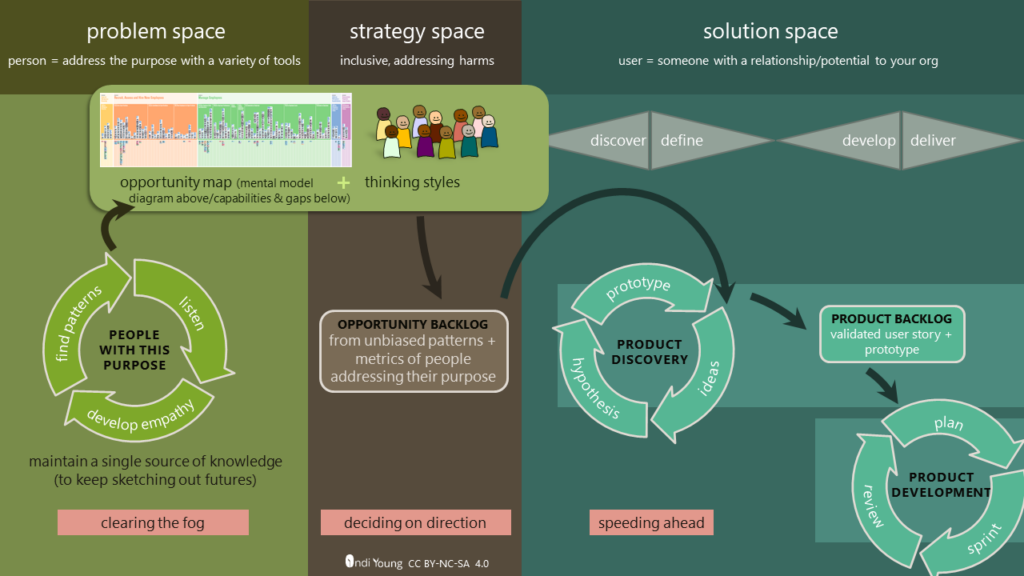Why Problem Space?
Put some space between “pattern” & “action!”
The problem space is a person’s domain. It’s where they are addressing something they want to make progress on, or put off, or just think about. The problem space is separate from your solutions, although the person may reach out for your tool along the way. People also reach out for other tools, they consult their memories, they chat with others, and even use mechanical and manual tools. So, the problem space is that person’s context.

Between your solutions and the person’s problem space should be an intentional strategy space. Often the strategy that drives an organization’s solutions is more reactive, instead of intentional. Strategy is often reactive to competition, reactive to big data about people using your solutions, or reactive to methods the executives or managers have gotten interested in. To ensure an organization’s longevity and sustainability, strategy needs to be inclusive, and it needs to be supportive.
Intentionally driven strategy is informed by knowledge about people in the problem space. It’s informed by how people address different purposes that your organization wants to support. It’s informed by gaps between their approaches and your solutions. An opportunity map shows these gaps and gives you help and harm benchmarks against which you can improve. Most organizations are surprised to discover that these gaps exist, and filling the gaps is a play allow more people to accomplish their purpose their way–reaching for your solutions.
Most organizations concentrate their efforts around the discovery and development of solutions. These organizations operate in the solution space where speed is of the essence. Metrics are based on “users” doing what the organization intended: engagement, OKRs, KPIs, etc. Every tool and method is then aimed at “customers,” “passengers,” “members,” “participants,” or any of those other nouns you might use to reference somebody that the organization is trying to support or market to. This focus has meant that the tools of the solution space do not allow you to understand people beyond the narrow lens of their relationship to your solutions.
What keeps you up at night
Building products & services is hard. But it’s even harder to create products & services that meet the actual needs of people, and thereby provide a competitive advantage and a viable path to success. True, there is a growing body of frameworks to aid you on that path. And yet, how many times have you gone through the process of discovery, experimentation, and scaling, diligently following one or the other framework only to find the results disappointing? How many times have you had to abandon a goal or metric, or found that it has fallen short of supporting those it was purported to support?
The question is, why it is that despite the increasing productivity of teams, and the abundance of new frameworks, solutions fail. From Facebook to Amazon, organizations are realizing that some of their best solutions are actually harming the humans they purport to support.
Some of the challenges we face:
- All that teams know of the people their work supports is the sliver of information the org gathers through the usage of their solutions
- The lack of deep understanding is compounded by the rapid pace of solution development
- Teams are often prohibited from using all the research tools at their disposal
- Orgs are guided by metrics that focus only on the org’s intentions, not the people they seek to serve
- Teams can unwittingly introduce bias and false assumptions in their findings
- The solutions these orgs create, at best, serve a subset of people well, but leave most people with an ill-fitting experience. At worst, they harm those who could benefit most.
Harness the power of deep understanding
When paired with big data trends, solution space research, design thinking, JTBD, lean UX, and agile methods, opportunity maps allow organizations to hold a wealth of data in one place. Thinking styles let you activate better support for far many more people.
You can make solutions that truly support various approaches and thinking styles as opposed to an “average” one-size-fits-all attempt. You can help your organizations realize they’ve not invested enough in understanding the problem space.
The problem space is about understanding people and their larger purpose. Try to understand the person’s purpose without relationship to a solution or a specific organization. Sometimes, it scares organizations when they have to forego “users” and “customers” in favor of “persons”. But if we realize that what brings any person to our organization in the first place is the alignment of a piece of their purpose with our offerings, it makes sense to invest in a holistic understanding of their purpose. This robust understanding would then become the fertile ground upon which we can cultivate innovations that stick, ideas that truly serve different subsets, and growth that is sustainable.
Today, organizations are starting to realize they’ve not invested enough in understanding the problem space. They’ve been spending budget studying their solution, its design, and its use through quantitative and qualitative methods. But they haven’t balanced that by understanding the problems people are trying to solve in the first place.
The Problem Space Method
Understanding the problem space takes different skills than traditional user research. If you are interested in learning about my process, the following links could give you a great start:
